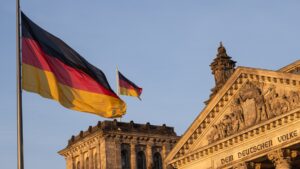Germany’s Economic Landscape: Navigating Growth Amid Challenges
Germany, often regarded as Europe’s economic powerhouse, recently experienced a slight expansion of 0.2% in its economy during the first quarter of 2023. While this growth offers a glimmer of hope, it comes amidst a backdrop of tariff tensions with the U.S. that threaten its economic future.
A Fragile Rebound
According to preliminary data released by Germany’s federal statistics office, this growth figure has been adjusted for seasonal, price, and calendar changes, aligning with economists’ estimates. In contrast, the country faced a contraction of 0.2% in the previous quarter. The uptick can primarily be attributed to increased household consumption and capital formation, indicating that private spending is driving this modest recovery.
However, Germany’s economy has been characterized by inconsistency, swinging between periods of growth and contraction throughout 2023 and 2024. Despite avoiding a technical recession—defined as two consecutive quarters of negative growth—the outlook remains precarious.
Key Struggles
Several critical sectors are under strain. The automotive industry, which significantly contributes to the economy, faces intensified competition from Chinese manufacturers. Meanwhile, housing and infrastructure projects are plagued by rising costs, reduced investment, and bureaucratic hurdles that stifle growth.
Equally concerning is the impact of U.S. tariff policies, which have injected uncertainty into Germany’s robust export sector. Being heavily reliant on trade—particularly with the U.S., its most important trading partner—the country has felt the sting of a 20% blanket tariff on exports. Though these tariffs have been temporarily reduced to 10% to facilitate negotiations, the economic repercussions are palpable.
A Shift in Economic Outlook
In light of these challenges, the German government has recently revised its economic projections, expecting stagnation in 2025. Outgoing Economy Minister Robert Habeck emphasized that the uncertainties stemming from Trump’s trade policies were instrumental in this adjustment.
Nevertheless, there’s a beacon of optimism emerging from recent fiscal reforms. Germany has amended its long-standing debt brake rule, allowing for increased defense spending and paving the way for a substantial €500 billion ($570 billion) fund dedicated to infrastructure and climate investments. This bold move reflects a recognition of the need for investment in future resilience and could be pivotal for revitalizing the economy, though effective implementation will be key.
Inflation Intricacies
While economic growth remains sluggish, inflation has begun to stabilize. As of March, the harmonized consumer price index registered at 2.3%—a drop from February’s 2.6%—moving closer to the European Central Bank’s target of 2%. Early estimates for April suggest a further decline to 2.1%, offering a silver lining in an otherwise tumultuous economic environment.
Conclusion
As we monitor these developments, it’s clear that Germany’s economic journey is fraught with challenges and opportunities. The interplay of global trade relations, domestic investments, and consumer behavior will largely determine the path forward. At the Extreme Investor Network, we remain committed to providing in-depth analysis and insights that allow investors to navigate this complex landscape effectively. Stay tuned for further updates and expert insights on how to position your investments in response to these unfolding economic dynamics.

